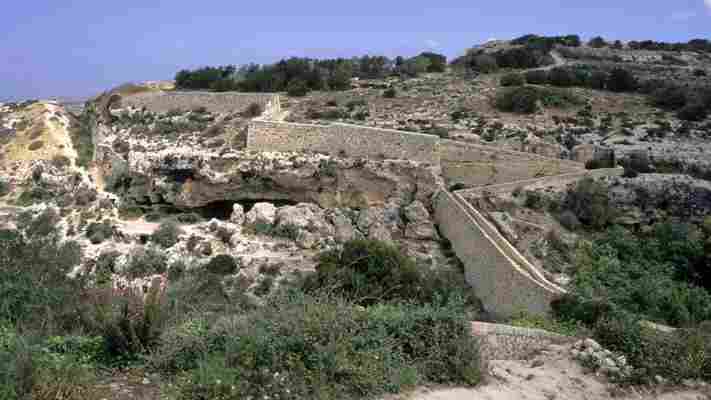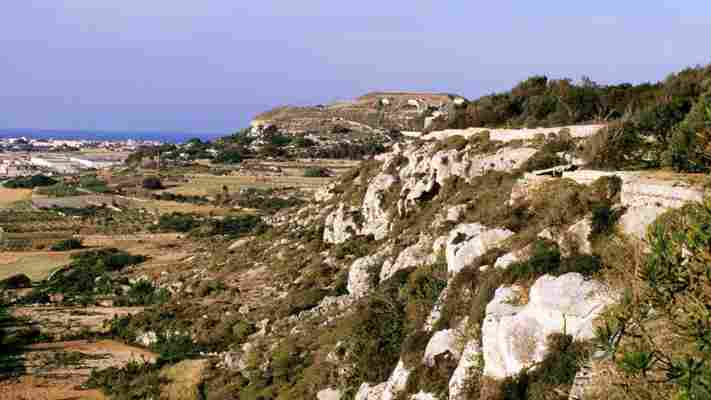With a population density predicted to reach 6,700 per sq km in the next 10 years , Malta is easily one of the European Union’s most crowded countries. And with more and more visitors flocking to the scenic Mediterranean archipelago every year, it’s hard to imagine that any corner of this destination remains undiscovered.

Yet there is one. Across the northern portion of the isle of Malta is a spectacular defensive line which has incredibly lain abandoned for decades.

Stretching 12km across northern Malta, the Victoria Lines have lain abandoned for decades (Credit: Charles O. Cecil/Alamy)
Known as the Victoria Lines and strategically built on the edge of a natural fault, this continuous defensive wall spans the entire width of Malta, some 12km from Fomm ir-Riħ in the west to Madliena in the east. But unlike the stately Grand Harbour of Valletta or imposing medieval town of Mdina, few will have even heard of the Victoria Lines, let alone seen them.
You may also be interested in: • The wildest edge of the Roman Empire • The Camino de Santiago’s ancient secret • The other Great Wall no-one knows
“What a revelation, to find so much nature and tranquility,” said Helen Jones Florio, long-time Malta resident and keen rambler who didn't even know of the Victoria Lines' existence until she walked the entire length recently. “From our starting point in a small village near Mgarr, on the west coast of Malta, we walked across the entire country.”
Malta's answer to China's Great Wall, the Victoria Lines are a network of fortifications built by the British Army during the second half of the 19th Century, consisting of forts, batteries, entrenchments and howitzer positions, and a continuous infantry line that connects them all together.
“From the bastions we had panoramic views of the island, and north on the horizon we could see the rocky outline of Malta’s sister islands of Gozo and Comino,” said Florio’s husband, Jason, who walked the Victoria Lines with her. “Then just east of Mosta we walked down into the craggy Wied il-Ghasel – Valley of Honey – where tucked into an overhanging cliff we found the tiny Chapel of St Paul the Hermit.”

The Victoria Lines, a network of forts, batteries, entrenchments and howitzer positions, is Malta’s answer to China’s Great Wall (Credit: Charles O. Cecil/Alamy)
Begun in the late 1800s by the Royal Engineers, and inaugurated in 1897 (the same year as Queen Victoria’s jubilee), the wall was designed to link together a number of detached forts and to provide one long, continuous path for British military patrols. At the time, Britain was wary that some other country – primarily France and the newly created kingdom of Italy – might seek to hijack its vital bases in the Mediterranean.
But it was the opening of the Suez Canal in 1869, which allowed European powers to access their territories in India and Asia without circumnavigating Africa, that was probably the most significant factor behind the building of the Victoria Lines. With more and more ships traversing the Mediterranean Sea, Britain’s stronghold on Malta became increasingly strategically important.
Nowhere in the Maltese islands is geography so emphatically exploited for defence
Natural cliffs in the west and a string of forts in the south protected the rest of the island, but the fear was that any land attack on the rear of Valletta's Grand Harbour in the east and her naval installations could prove devastating to the British fleet. That left the north end of Malta as the only vulnerable area – save for the Great Fault line along which several infantry entrenchments had already been fashioned in the early 18th Century by the Knights of Malta.
“Nowhere in the Maltese islands is geography so emphatically exploited for defence than along the line of natural escarpments known as the Great Fault,” writes military historian Dr Stephen C Spiteri in his book A Guide to The Fortifications of Malta.
Despite Britain’s fears, the Victoria Lines were never put to the ultimate test of an enemy invasion, and by 1907, had already been abandoned and troops relocated to the island’s coastlines. When a Nazi invasion looked likely during World War Two, the lines were rehabilitated with new guard posts built along them as a second line of defence. But once again, the fortifications escaped skirmish.
Inaugurated in 1897, the Victoria Lines never saw battle (Credit: Charles O. Cecil/Alamy)
The Victoria Lines’ anonymity is about to change, however. Just as hiking and rambling are surging in popularity, only now is Malta beginning to wake up to the fact that they have a glorious untapped treasure on their hands. By the end of the year, the Maltese Tourism Authority hopes to introduce visitors to this hidden gem with the designation of the nation’s first national walkway, which will lead hikers along the historical battlement.
“We are currently working on setting up two trails along the Victoria Lines from Kuncizzjoni to Mosta, and from Gharghur to Pembroke,” said Stephanie Attard Grech, who is overseeing the new project as assistant manager at the Maltese Tourism Authority.
The long-awaited launch of the Victoria Lines trail will be met with particular excitement by those enthusiasts in Malta – particularly in the north-central Maltese town of Mosta – who have been pushing steadily for its creation for more than 20 years. Mosta’s residents were inspired to preserve the battlement by the UK’s effort to promote Hadrian’s Wall as a continuous walking trail, kicking off their own efforts with a celebration of the Victoria Lines’ centenary anniversary in 1997.
Those familiar with the project hope a national trail will attract a new form of responsible, high-quality tourism; put Malta on the European ramblers’ map; and ensure a greater level of protection for this piece of the archipelago’s cultural heritage and the landscape surrounding it.
“This is something that can only be fully appreciated if one actually walks along the Victoria Lines,” said Ray Cachia Zammit, who created the Facebook page, Friends of the Victoria Lines Trail . “Dedicated trekkers and ramblers already manage to do this despite the many current obstacles, but a managed national trail would extend this experience to the wider public, both locals and tourists,” he said.
A new national trail will allow hikers and ramblers to enjoy dramatic views of Malta from the Victoria Lines (Credit: Charles O. Cecil/Alamy)
Zammit is the first to admit walking along various parts of the Victoria Lines can be difficult because of overgrown vegetation and other hazards (there are places where parts of the wall have collapsed and even a tract that has disappeared altogether). However, a walk along the Victoria Lines is “a unique experience through the stunning beauty of Malta's landscapes, offering breath-taking views”, he said.
If you haven't walked the Victoria Lines then you have not seen Malta
The battlement is at its most spectacular where it snakes dramatically up and down a number of valleys. “At times we were left gripping the wall in fear that a misplaced step would lead to a tumble,” Jason said. “But the joy of walking the Lines is the variation. The smooth flat sections around the forts giving way suddenly to tight, crumbling paths and finally those rugged snaking ramparts along cliff edges that give it the look of a diminutive Great Wall of China.”
His views are echoed by the growing number of followers on the Friends of the Victoria Lines Trail Facebook page, all hoping to preserve the lines for future generations. After all, according to member George Wayte: “If you haven't walked the Victoria Lines then you have not seen Malta.”
Join more than three million BBC Travel fans by liking us on Facebook , or follow us on Twitter and Instagram .
If you liked this story, sign up for the weekly bbc.com features newsletter called "The Essential List". A handpicked selection of stories from BBC Future, Culture, Worklife and Travel, delivered to your inbox every Friday.
Leave a Comment